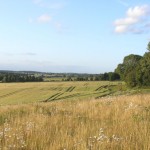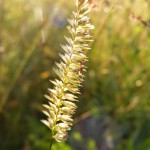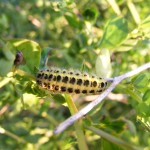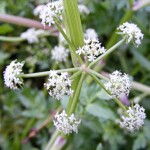Eleven members and friends met at Snelsmore Common with the intention of walking to an area of land between Winterbourne and Bussock Mayne that had appeared to be a promising site for wildlife when visited in the winter. The walk, led by Chris Bucke, took in varied terrain, first the acid heathland typical of the common, where Cross-leaved Heath (Erica tetralix) was reaching its best and precocious specimens of Bell Heather (Erica cinerea) and heather (Calluna vulgaris) were showing colour. A boletus species was noted, encouraged into growth by the recent moist weather. By the roadside approaching Winterbourne Holt a large colony of Leopard’s Bane (Doronicum pardalianches) was at the end of its flowering season. Nearby were the handsome seed heads of another garden escape, Honeybells (Nectaroscordium siculum) and many plants of Stinking Gladdon (Iris foetidissima) in full bloom. The track leading to Pebble Lane was bordered by a spectacular display of Foxglove (Digitalis purpurea) and beside Pebble Lane the unusual combination of Creeping Jenny (Lysimachia nummularia) and Yellow Pimpernel (Lysimachia nemorum) grew intertwined.
From Pebble Lane the route took us through a hayfield with many species of grass in full bloom, then over a style into the target area, a very wide headland above a field of barley. In a small distance there was an area of the acid heathland, then a layer of sticky yellow clay and below this gravelly, probably alkaline, soil. Ox-eye daisies (Leucanthemum vulgare) made a splendid show, interspersed with a yellow trefoil (Trifolium dubium probably), Knapweed (Centaurea nigra) all of which had ray florets, a few specimens of Sainfoin (Onobrychis viciifolia), a large Bird’s Foot Trefoil (Lotus corniculatus, probably the introduced var. sativus) and much more. A few specimens of Broomrape (Orobanche minor) were noted and the likelihood that the lower levels of our area were alkaline was supported by the appearance of a single specimen of Ploughman’s Spikenard (Inula conyzae).
Conditions were not ideal for recording insects but Meadow Browns and Marbled Whites were seen and a Yellow Shell moth. One member anticipated finding Purple Emperors on the walk but he was disappointed, sadly.
The yard of the apparently derelict Winterbourne Farm provided interest, a large heap of soil having many specimens of Bugloss (Anchusa arvensis) and a spectacular double-flowered Papaver somniferum. Some Mulleins (Verbascum thapsus) were infested with caterpillars of the Mullein moth. The stream beside the road through the village of Winterbourne had both Water-cress (Rorippa nasturtium-aquaticum) and Fool’s-water-cress (Apium nodiflorum) in flower.
The walk back was enlivened by some dexter cattle, including a charming very young calf. As we neared the car park in the dusk a Woodcock flew overhead. The conclusion of the expedition was that the grassland area was interesting and worthy of more attention but not very interesting.
Report by Chris Bucke
Pictures by Rob Stallard




